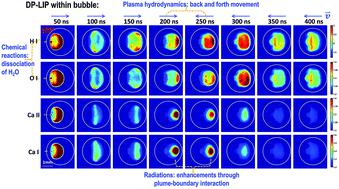当前位置:
X-MOL 学术
›
J. Anal. At. Spectrom.
›
论文详情
Our official English website, www.x-mol.net, welcomes your feedback! (Note: you will need to create a separate account there.)
Spatiotemporal and spectroscopic investigations of the secondary plasma generated during double-pulse laser-induced breakdown in bulk water
Journal of Analytical Atomic Spectrometry ( IF 3.4 ) Pub Date : 2020-10-24 , DOI: 10.1039/d0ja00139b Boyang Xue 1, 2, 3, 4 , Ye Tian 1, 2, 3, 4 , Nan Li 1, 2, 3, 4 , Qingyang Li 1, 2, 3, 4 , Yuan Lu 1, 2, 3, 4 , Ronger Zheng 1, 2, 3, 4
Journal of Analytical Atomic Spectrometry ( IF 3.4 ) Pub Date : 2020-10-24 , DOI: 10.1039/d0ja00139b Boyang Xue 1, 2, 3, 4 , Ye Tian 1, 2, 3, 4 , Nan Li 1, 2, 3, 4 , Qingyang Li 1, 2, 3, 4 , Yuan Lu 1, 2, 3, 4 , Ronger Zheng 1, 2, 3, 4
Affiliation

|
Double-pulse laser-induced breakdown spectroscopy (DP-LIBS) has been demonstrated to enable efficient elemental analysis of bulk water. Its applications are based on the fundamental understanding of the characteristics of the secondary plasma. However, due to the poor stability of the secondary breakdown, the inherent formation and evolution processes of the secondary plasma within the first laser formed bubble (LFB) remain unknown. By post focusing the second laser beam at the rear boundary of the first LFB (post-focus arrangement), the generated secondary plasma can provide a stable system for understanding its spatiotemporal behaviors. Based on this post-focus arrangement, the secondary plasma was characterized by using temporally resolved spectroscopy, monochromatic fast imaging and shadowgraph techniques. It was shown that the emission of underwater DP-LIBS presented transient increments within 1 μs. Such a distinctive temporal behavior was closely related to the back and forth movement of the secondary plasma within the first LFB, due to its spatial confinement effect. Species-specific imaging studies reveal that the interactions between the secondary plasma and the surrounding water vapor can give rise to the dissociation of water molecules, as well as the excitation of hydrogen and oxygen atoms. Meanwhile, the molecular emissions (CaOH) appeared only after 2 μs, but lasted for 32 μs, suggesting a slower plasma relaxation within the first LFB. Further shadowgraphic investigations highlight the quasi-static, low-pressure environment of the first LFB, which can reduce energy losses and enhance optical radiation from the secondary plasma.
中文翻译:

散装水中双脉冲激光诱导击穿过程中产生的次生等离子体的时空和光谱研究
已证明双脉冲激光诱导击穿光谱法(DP-LIBS)能够对大量水进行有效的元素分析。它的应用基于对次级等离子体特性的基本了解。但是,由于二次击穿的稳定性差,因此在第一激光形成气泡(LFB)中二次等离子体的固有形成和演化过程仍然未知。通过将第二激光束后聚焦在第一LFB的后边界上(聚焦后布置),生成的辅助等离子体可以提供一个稳定的系统来理解其时空行为。基于这种后聚焦布置,通过使用时间分辨光谱,单色快速成像和阴影图技术来表征次级等离子体。结果表明,水下DP-LIBS的发射在1μs内呈现出瞬时增量。由于其空间限制效应,这种独特的时间行为与次级LPF在第一LFB中的来回运动密切相关。特定物种的成像研究表明,次级等离子体与周围水蒸气之间的相互作用可以引起水分子的离解,以及氢和氧原子的激发。同时,分子发射(CaOH)仅在2μs后出现,但持续了32μs,表明第一个LFB中的等离子体弛豫较慢。进一步的影像学调查突显了第一个LFB的准静态低压环境,这可以减少能量损失并增强来自次级等离子体的光辐射。
更新日期:2020-11-16
中文翻译:

散装水中双脉冲激光诱导击穿过程中产生的次生等离子体的时空和光谱研究
已证明双脉冲激光诱导击穿光谱法(DP-LIBS)能够对大量水进行有效的元素分析。它的应用基于对次级等离子体特性的基本了解。但是,由于二次击穿的稳定性差,因此在第一激光形成气泡(LFB)中二次等离子体的固有形成和演化过程仍然未知。通过将第二激光束后聚焦在第一LFB的后边界上(聚焦后布置),生成的辅助等离子体可以提供一个稳定的系统来理解其时空行为。基于这种后聚焦布置,通过使用时间分辨光谱,单色快速成像和阴影图技术来表征次级等离子体。结果表明,水下DP-LIBS的发射在1μs内呈现出瞬时增量。由于其空间限制效应,这种独特的时间行为与次级LPF在第一LFB中的来回运动密切相关。特定物种的成像研究表明,次级等离子体与周围水蒸气之间的相互作用可以引起水分子的离解,以及氢和氧原子的激发。同时,分子发射(CaOH)仅在2μs后出现,但持续了32μs,表明第一个LFB中的等离子体弛豫较慢。进一步的影像学调查突显了第一个LFB的准静态低压环境,这可以减少能量损失并增强来自次级等离子体的光辐射。

























 京公网安备 11010802027423号
京公网安备 11010802027423号